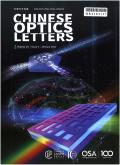Comparison of optical properties of bioaerosols composed of microbial spores and hyphae [Invited]
IF 2.8
2区 物理与天体物理
Q2 OPTICS
引用次数: 0
Abstract
Bioaerosols exhibit significant broadband extinction performance and have vital impacts on climate change, optical detection, communication, disease transmission, and the development of optical attenuation materials. Microbial spores and microbial hyphae represent two primary forms of bioaerosol particles. However, a comprehensive investigation and comparison of their optical properties have not been conducted yet. In this paper, the spectra of spores and hyphae were tested, and the absorption peaks, component contents, and protein structural differences were compared. Accurate structural models were established, and the optical attenuation parameters were calculated. Aerosol chamber experiments were conducted to verify the optical attenuation performance of microbial spores and hyphae in the mid-infrared and far-infrared spectral bands. Results demonstrate that selecting spores and hyphae can significantly reduce the average transmittance from 21.2% to 6.4% in the mid-infrared band and from 31.3% to 19.6% in the far-infrared band within three minutes. The conclusions have significant implications for the selection of high-performance microbial optical attenuation materials as well as for the rapid detection of bioaerosol types in research on climate change and the spread of pathogenic aerosols.微生物孢子与菌丝组成的生物气溶胶光学性质比较[特邀]
本文章由计算机程序翻译,如有差异,请以英文原文为准。
求助全文
约1分钟内获得全文
求助全文
来源期刊

Chinese Optics Letters
物理-光学
CiteScore
5.60
自引率
20.00%
发文量
180
审稿时长
2.3 months
期刊介绍:
Chinese Optics Letters (COL) is an international journal aimed at the rapid dissemination of latest, important discoveries and inventions in all branches of optical science and technology. It is considered to be one of the most important journals in optics in China. It is collected by The Optical Society (OSA) Publishing Digital Library and also indexed by Science Citation Index (SCI), Engineering Index (EI), etc.
COL is distinguished by its short review period (~30 days) and publication period (~100 days).
With its debut in January 2003, COL is published monthly by Chinese Laser Press, and distributed by OSA outside of Chinese Mainland.
 求助内容:
求助内容: 应助结果提醒方式:
应助结果提醒方式:


